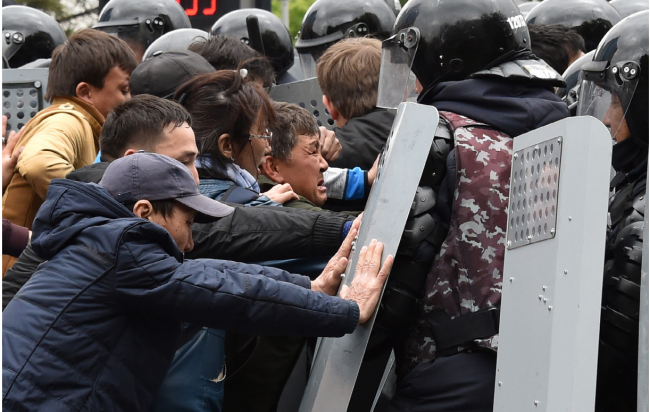
This report analyzes what helps and harms civic mobilizations in countries governed by hard authoritarian regimes. Previous research has shown that social movements are much more likely to achieve their goals if they reach a certain participation threshold. What, however, enables the growth of social movements toward that threshold in the face of authoritarian repression? While the existing literature addresses success factors for movements with maximalist demands (those calling for regime change, for example) and the factors leading to stable democratization, this research fills a gap in understanding what happens in the phase of mobilization growth, whatever the movement’s goals may be and whether or not they are achieved.
...In this report, we examine the main factors that were related to successful mass mobilization in episodes we studied. While each case has a unique combination of circumstances that explain the mobilization growth, we observed several common factors across cases. These findings form the basis of this report and our recommendations for practitioners.
View report
Common factors in cases of mobilization growth
Factor 1: New leadership.
Leaders of successful movements often come from outside established opposition groups. In our cases, they included entrepreneurs, artists, environmentalists, and members of youth movements. Prodemocracy activists are not usually the ones to initiate or lead broad-based movements, but their support can improve the chances that anascent mobilization will grow, as they have technical expertise and experience dealing with the regime. However, they are hindered both because they are
typically known to the government which can quickly repress them, and because they are sometimes perceived as an “old guard” seeking personal gain and disconnected from grassroots concerns. In the cases in our study where the mobilization was led by members of an entrenched and
fractured opposition, they were successful when they were able to unify or join forces with new social movements.
Factor 2: Renewed framing.
While many authoritarian regimes use violence and propaganda to ensure compliance, they also care about constructing a narrative that legitimizes
their rule. Usually, regime leaders do so by connecting their leadership to societal values, such as fairness or security, and group identities, including ethnic, religious, or class ones. When a movement credibly calls into question whether the government has lived up to its ideals, and presents an alternative vision of the future that speaks to the same societal values the regime invokes, it is more likely to grow.
Recommendations for practitioners and donors
1. Practitioners and donors tend to work with lawyers, journalists, human rights activists, policy researchers, and election monitors. Social movements in authoritarian contexts need the support of professionals with the skills that this kind of assistance builds and sustains. Assistance
that helps these established, in-country professionals sustain their work even when there is no window for change allows them to support an emergent civic mobilization in ways that new activists cannot.
2. Use organizational prestige and convening power to create opportunities for groups who could play an important role in a future civic mobilization to connect with prodemocracy partners and each other. These include professional organizations, entrepreneurs, environmental
movements, and student groups, among others. For donors, this may require more internal coordination across different departments and grant mechanisms.
3. Support partners so they may engage in peer-to-peer or offshore training, and scholarship on nonviolent, nonconfrontational, and innovative tactics.
4. Support partners’ use of communication tools that are not easily monitored or blocked by the government. Fund the engagement of outside information and communications technology (ICT) security experts who know how to stay one step ahead of the regime. Adapt your own policies and procedures to meet the needs of local partners.
5. Learn about and build connections to diaspora groups and their activities—with an awareness that the politics of a diaspora can be difficult for outsiders to navigate.
6. Plan for a pool of funding to respond rapidly to situations where a movement has emerged, and where state repression was not immediate or did not result in the cessation of the movement. The response should provide both technical and psychosocial support to partners who can safely receive funding. Support activities may also take place abroad.
Recommendations for movements and activists
1. Customize messaging for different audiences when developing communications strategies. Movements and activists may need to be flexible about the language of rights to help prodemocracy frameworks more directly address local concerns and counter a regime’s claim to uphold common values.
2. Diversify networks. Use professional and personal relationships to connect your movement or organization with professional groups, entrepreneurs,environmental movements, student groups, and others who may play an important role in a future civic mobilization. Assess the diversity of the groups you are in regular communication with about issues in your country, and address gaps by working to establish new relationships. For some groups, there may be less sensitive issues that you can raise to form a connection and share expertise. Maintain friendly ties with influential acquaintances who don’t share your views now but may change their minds if the tide starts
to turn
3. Find trustworthy ICT experts to give advice on digital security, or deputize a wise amateur to be your help desk, and follow up by building organizational habits that support safer communication among your network members. Use creative financing, perhaps through diaspora networks, to support access to systems like satellite telephones.
4. Seek out opportunities for peer-to-peer learning from other civic movements abroad. Their experiences may have relevance for your own communication or strategy even if their cultural or historical context differs significantly. Ask donors or other supporters to help you make these connections and to provide opportunities to convene with other groups abroad.
5. Consult international best practices for nonviolent movement building and share them widely within your networks. Having a shared tactical repertoire and analytical framework for understanding the dynamics between your movement and the regime can increase the efficacy of your actions. Also, consider engaging international experts on nonviolent action who may be able to assist with training, strategizing, and coordination.

